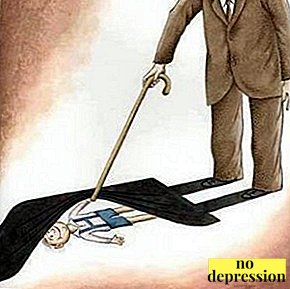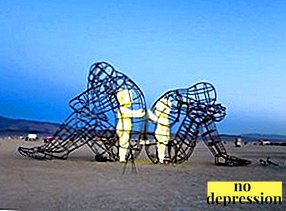Adults sometimes behave like children. This is manifested through pranks, playfulness, delight, charm and uncontrollable creative impulses.
At such moments, consciousness is controlled by the so-called “Inner Child”, which is in each of us.
What it is?

The concept of "Inner Child" is actively used in psychotherapy and means part of consciousnessthat accommodates experiences from childhood and the prenatal period of development.
The Inner Child (hereinafter BP) is one of the ego states.
A person has three states: Inner Child, Inner Adult and Inner Parent. Each of them is a set of behavioral reactions, attitudes, feelings and thoughts.
How does a person in a child’s state behave and how does he feel?
Child able man living their childhood experiences. If he previously received enough love and care from his parents, BP will be happy and healthy.
When BP is healthy, a person rejoices in trifles, is ready to communicate with others, is creative, does not feel moral fatigue, and comes in harmony.
If a person as a child was ignored, offended, intimidated, humiliated and mocked, then Inner Child will be sick. In this case, BP is scared, aggressive and not capable of building normal relationships with others.

A person in the state of the Child behaves infantile, commits rash acts and is guided by its inner “want!”.
At the same time, he is creatively active and sociable, playful and sincere in his actions, words and feelings.
If BP gets in the driver’s seat, the person reacts to any situation in the present, how would he react to her in childhood.
How to meet your BP?
If a overwhelm your inner child or try to ignore it, it will lead to neurosis, insomnia, breakdowns and depression, as well as the loss of some of its potential and abilities. After all, the child is responsible for the creative thinking of BP.
To hear the inner child and get to know him, you must try to call him to talk. To do this, imagine BP in your head as a kind of image dwelling in a room called “consciousness”.
What does he look like? What is he wearing? How does one behave and how does one greet? What emotions translates their behavior? Is there someone with him, or is he always alone? What does he want to tell his Adult?

If it’s hard to get an image of BP in your head, start with childhood memories. Remember yourself, your experiences and desires.
Most often, poorly established contact with the inner child manifests itself as delayed emotions.
Already after the incident that caused emotional response, a person is crying, frightened, worried or offended.
At the same time, feelings and their manifestations have a truly childlike nature and the absence of “adult” prerequisites and their manifestation. Solid uncles and aunts suppress these emotions.
But in order to get acquainted with BP, you will have to give free rein to consciousness, crying, screaming and laughing, obeying the Child. You have to live the emotions that your BP is broadcasting.
How to communicate with him?
If the Inner Child forgotten and abandoned, person:
- withdraws into himself and ceases to feel confident in society;
- hides his real feelings (whether it is shame, the desire to find a profit, or the fear of being uncomfortable);
- from time to time a person feels tired;
- sometimes there are bouts of uncontrolled irritation;
- you have to force yourself to do certain things.

In order to purposefully begin communication with BP, you need to enter state of relaxation.
To do this, you can meditate or just stay alone and turn away from the outside world, forget about the problems.
- Use to communicate images, because the creative child willingly reacts to them. You can imagine a meadow, a corridor or a castle to which you invite BP to talk. Colorfully imagine your way to this place, thrill before the upcoming meeting.
- The child may already be waiting for you at the designated place, or appear a little later. Be patient.
You may not be able to contact the ego state the first time if you have always ignored it before.
- When the child comes to the meeting, repent before him. Ask for a petition for always disregarding it and often trying to suppress it. BP should accept your apologies, and answer affirmatively to the friend request.
- Now that BP has become your friend, you can communicate with him directlyby listening to your emotions online.
Rules of work

In childhood we have to meet with traumatic experience.
Parents refused to buy the desired toys, at school they gave an offensive nickname or took a briefcase.
Mom called it stupid, and dad gave it a belt. All this imprinted in us and forms an ego state.
The relationship between a person and his Inner Child is always a copy of the relationship between the person himself and his parents. In the case of a destructive relationship, it’s important:
- Make it so that a person can sympathize with his BP, and not show aggression towards him.
- Create conditions in which a person can support his Inner Child and help outlive negative emotions.
We cannot cancel the traumatic event, because it has already happened and affected the ego state. But we can rethink that experience, replacing it with more successful ones. To do this, and spend work with the Inner Child.
An adult returns to the situation from childhood, which gave rise to negative feelings. But now he interferes with the process, giving the Child a tool for coping. Now the experience that has already been experienced once, will take a positive color.

Example: The woman was very offended and burst into tears when her husband canceled the trip to the cafe because of work.
The presence of a valid reason for the correction of plans and the absence of soil for resentment pushed the woman to visit group psychotherapy.
In the process of analyzing the situation and playing the scene of a quarrel with her husband, the woman begins to cry again.
To the question of a psychologist, “How old are you now?”, He answers: “Six.”
It is at this age that the client got a traumatic experiencewhen the mother promised to take her daughter to the cinema, but refused after the girl accidentally spilled water on herself before leaving the house.
Mom pointed out to her daughter how untidy she is. After that, the client was punished and left alone in the room, experiencing resentment, pain and guilt.
To correct the experience, the client mentally addresses her BP with the words of support at this moment, using the image of a good sorceress.
Rules for working with an internal child:
- be patient and do not expect the ego state to make contact immediately;
- accept and live the feelings that you experience, even if they run counter to your ideas about your own image (a solid man cannot be afraid of a moth, and an independent woman does not want to feel a feeling of dependence on her husband);
- within reason, indulge your whims (after all, these are the vagaries of your BP).

If the Inner Child is injured, and the causes of this injury are lost deep in childhood and cause a flurry of negative emotions, it is not worth working with the ego state without the help of a specialist.
Healing Exercises
Simple Steps for Healing the Inner Child:
- take responsibility for satisfying the wishes of BP;
- replace negative beliefs of BP with new and positive attitudes;
- to work out the stages of development that were not passed in childhood;
- use positive messages addressed to BP;
- perform exercises for healing BP.
- Exercise "I give you the desire". Try to go back to your childhood and remember what you loved to do. Take a piece of paper and write down your ideas. This can be any of your children's entertainment (jumping on the armchair, painting with colors, collecting twig figures, dressing up in beautiful clothes, climbing trees, etc.). When you have 20 points, go to the execution of the tasks.
- Exercise "Support". Find children's photos in which you are under 6 years old. Carefully consider your facial expression in these photos. What does it emit? Joy or dismay? Is the kid happy with his life? Now talk to the photo. Ask the child why he looks sad or scared. Talk to the baby. Tell them you love and accept it. Say that you will always protect the child and be proud of him.
- Exercise "Letter". Take two markers. Contact your Inner Child to contact them. Then take a marker in each hand. With a dominant hand, write questions about BP on a piece of paper. And with a non-dominant hand, BP will respond to you.
- Exercise "Celebration". Arrange a holiday for your Inner Child. You can do it mentally, if contact with BP is already well established. If not, use external attributes (cake, caps, balls and crackers). Devote this holiday to your vulnerable ego state to instill confidence and a sense of self-worth in it.
Inner Child (especially if he is sick) is often mistaken perceived as an adversarywho is trying to undermine the stable emotional background of an adult and restrained person.
But the inner child is not your enemy. He is just a part of the consciousness that signals the presence of serious experiences and tries to draw attention to the problem.
The inner child lives in each of us. How important is it to us? Find out from the video:



